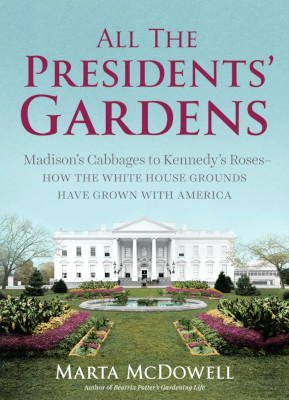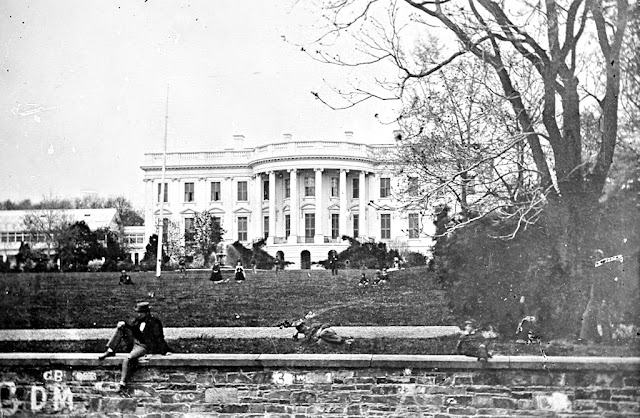I've loved reading Marta McDowell's previous books on Beatrix Potter, Emily Dickinson and Frances Hodgdon Burnett. She also has a book on Laura Ingalls Wilder that I have not read. This one is just as entertaining although it sat on my shelf for over a year before I finally decided to read it. I've never thought much of the White House gardens and when I visited Washington D.C. back in 2007, I can remember Dumbarton Oaks and the Exorcist stairs (!) but I only vaguely recall seeing the White House. What does that say about me?
I looked up my photos from that trip and sure enough, there were a few shots of the White House. I recall that we were a distance away from it but you can see from my photo below, there isn't much to see and any serious gardener is probably thinking "All that grassy area is really taking up some valuable real estate for plants." Granted, I do understand why they need these open areas for events and have room for people. Still - blah!
So, I was pleasantly surprised that I enjoyed the book and indeed found it very interesting. First of all, I did not realize the grounds were so large - 18 acres to be exact. James Hoban was the architect of the White House. George Washington contracted French-American military engineer Pierre Charles L'Enfant to plan the grounds as well as the surrounding city area (now known as the District of Columbia). He was later dismissed when he clashed with the planning commissioners but most of his plans would later be followed.
My photo of the White House and grounds taken on my visit in 2007 -
I knew that George Washington was a great plant lover (read Andrea Wulf's
Founding Gardeners and
The Brother Gardeners, both fantastic reads!) and I wasn't surprised that he personally ordered more than 200 trees and shrubs for the grounds. However, they would not be planted during his tenure and he would not live to see them in the ground. He died at his Mt. Vernon home less than two years after he left office.
George Washington also did not ever actually live in the White House. It was still under construction during his tenure. The second President, John Adams and his wife Abigail did move into the house near the end of his term. At the time, there were a total of six rooms finished.
I was surprised that the third President, Thomas Jefferson, America's "Patron Saint of Gardening," didn't achieve as much in the gardens but it was because he did not want to appear "grand" and run the risk of losing favor with the public. He did fence in the garden and worked more on the house. He also had the first Presidential pet - a mockingbird named "Dick".
The book is full of interesting facts like these and shows how each Presidential administration changed the landscape in some way although some didn't do that much (Eisenhower one was more interested in installing a putting green and a helicopter landing area (Eisenhower). Gerald Ford wanted a pool for his daily swims.
I never knew that greenhouses once played a significant role on the grounds -
Over the years, many prominent landscape designers have had their hand in the design. One of my favorites, Beatrix Farrand (she designed Dumbarton Oaks), laid out the East Garden at the request of Ellen Wilson, wife of Woodrow. It featured a lily pond. Decades later, Jacqueline Kennedy asked Rachel "Bunny" Mellon to redesign the garden and it became the Rose Garden as it is known today.
 |
| Edith & Woodrow Wilson in the East Garden, 1916. |
Below, the left photo shows the redesigned East Garden, now called the Rose Garden. The photo on the right as it appears recently. It is pretty much the same except the crabapples are gone and a sidewalk has been installed.
In 1935, President Roosevelt sought advice from Frederick Law Olmsted Jr. on improving the South Lawn. He emphasized the large trees and shrubs along the perimeter for privacy and an open vista in the central area so that the house could be seen by visitors. Which explains the view in the earlier photo that I took on my visit.
Here is an interesting photo from the 1860s that shows people lounging on a wall in front of the South Lawn. The wall was later removed in 1873. Note the graffiti on the wall! It looks like people have always felt the need to muck up public walls with their ugliness.
The book is generously illustrated with photographs, both historical and contemporary as well as maps, drawings, paintings, etc. There is a list of gardeners who have been employed by the White House with biographical information and a list of their notable contributions. An inventory of plants includes all the trees and shrubs and the dates that they have been in the garden.
This is another winner from Marta McDowell. I hear that her next book will focus on gardening themes in crime fiction. I will be looking forward to that.
Text and photos by Phillip Oliver, Dirt Therapy








I too have enjoyed a number of Marta's other books. Will check this one out. Have never been nor am I likely to go to DC so will visit vicariously through the book
ReplyDelete